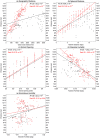Spatial Transmission of 2009 Pandemic Influenza in the US
- PMID: 24921923
- PMCID: PMC4055284
- DOI: 10.1371/journal.pcbi.1003635
Spatial Transmission of 2009 Pandemic Influenza in the US
Abstract
The 2009 H1N1 influenza pandemic provides a unique opportunity for detailed examination of the spatial dynamics of an emerging pathogen. In the US, the pandemic was characterized by substantial geographical heterogeneity: the 2009 spring wave was limited mainly to northeastern cities while the larger fall wave affected the whole country. Here we use finely resolved spatial and temporal influenza disease data based on electronic medical claims to explore the spread of the fall pandemic wave across 271 US cities and associated suburban areas. We document a clear spatial pattern in the timing of onset of the fall wave, starting in southeastern cities and spreading outwards over a period of three months. We use mechanistic models to tease apart the external factors associated with the timing of the fall wave arrival: differential seeding events linked to demographic factors, school opening dates, absolute humidity, prior immunity from the spring wave, spatial diffusion, and their interactions. Although the onset of the fall wave was correlated with school openings as previously reported, models including spatial spread alone resulted in better fit. The best model had a combination of the two. Absolute humidity or prior exposure during the spring wave did not improve the fit and population size only played a weak role. In conclusion, the protracted spread of pandemic influenza in fall 2009 in the US was dominated by short-distance spatial spread partially catalysed by school openings rather than long-distance transmission events. This is in contrast to the rapid hierarchical transmission patterns previously described for seasonal influenza. The findings underline the critical role that school-age children play in facilitating the geographic spread of pandemic influenza and highlight the need for further information on the movement and mixing patterns of this age group.
Conflict of interest statement
The authors have declared that no competing interests exist.
Figures



References
-
- Cliff AD, Haggett P, Smallman-Raynor M (1998) Deciphering global epidemics: analytical approaches to the disease records of world cities, 1888–1912; Press BU, editor. Cambridge. - PubMed
-
- Grenfell BT, Bjornstad ON, Kappey J (2001) Travelling waves and spatial hierarchies in measles epidemics. Nature 414: 716–723. - PubMed
-
- Viboud C, Bjornstad ON, Smith DL, Simonsen L, Miller MA, et al. (2006) Synchrony, waves, and spatial hierarchies in the spread of influenza. Science 312: 447–451. - PubMed
Publication types
MeSH terms
Grants and funding
LinkOut - more resources
Full Text Sources
Other Literature Sources
Medical

